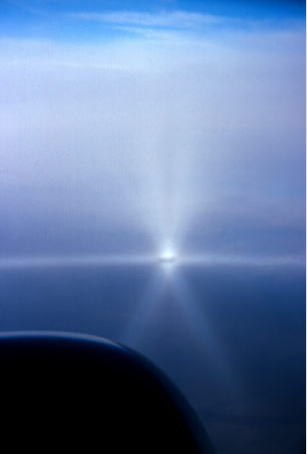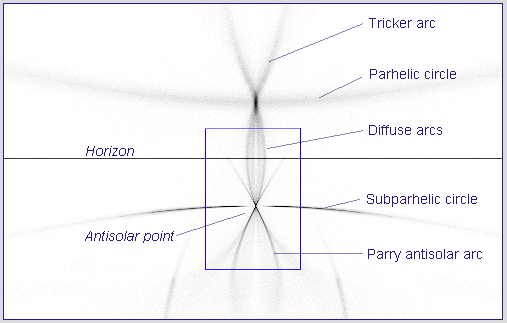Antisolar Region Arcs
Antisolar Region Arcs: A Fascinating Atmospheric Phenomenon
Have you ever witnessed a breathtaking display of light in the sky that left you in awe? If not, let me introduce you to a rare and dazzling atmospheric phenomenon known as "Antisolar Region Arcs." These arcs, which appear around the antisolar point, offer a mesmerizing spectacle that few are fortunate enough to witness.
The antisolar point refers to the location directly opposite the sun, and it is at this point that the arcs around the antisolar region form. Picture a bright diamond with the aircraft's shadow perfectly centered within it – that's the antisolar point. Now, imagine a horizontal halo passing through this point, forming a brilliant subparhelic circle. This circle is just one component of the intricate display of arcs that grace the sky.
The diagonal cross observed in the image captured by Virginia meteorologist Jacob Klee during a flight from Cincinnati to Richmond Virginia on November 12th, 2000, adds an extra layer of complexity to the scene. This cross is a combination of diffuse arcs from horizontal column crystals and an antisolar arc from Parry oriented columns. These elements intertwine to create a captivating visual feast for the eyes.
To better understand the phenomenon, let's delve into a simulation of the antisolar region arcs. By estimating the solar elevation to be 13.5° based on flight times and fitting it to the photograph, researchers were able to create a simulated representation of the observed arcs. The imaged area lies within a blue rectangle, while the Parry antisolar arc extends upwards from the antisolar point, forming the two outermost parts of the diagonal cross.
One intriguing characteristic of these arcs is their narrowness in comparison to their above-horizon counterparts. Even when crystal tilts are relatively large, the subhorizon arcs in the antisolar region remain remarkably slender. This peculiar feature adds to the mystique and allure of these atmospheric phenomena.
To recreate the simulation, researchers utilized a combination of crystal types, including 70% singly oriented column crystals, 15% Parry oriented columns, and 15% horizontal plates. The columns had c/a ratios ranging from 1 to 3, and their tilts varied from 0.5 to 5°. By incorporating these crystal compositions and properties, the simulation aimed to capture the intricate details of the observed arcs.
In conclusion, witnessing the enchanting display of Antisolar Region Arcs is an incredibly rare and remarkable experience. The combination of diffuse arcs from horizontal column crystals and antisolar arcs from Parry oriented columns creates a mesmerizing visual spectacle. These arcs, observed around the antisolar point, form a diagonal cross that adds an extra layer of complexity to the scene. With their narrowness and intricate composition, these arcs continue to captivate the imagination of skywatchers worldwide. Although sightings may be infrequent, those fortunate enough to witness these atmospheric phenomena are left with an indelible memory of nature's awe-inspiring beauty.

Arcs around the antisolar point.
An amazingly bright and rare display seen by Virginia meteorologist Jacob Klee on a flight from Cincinnati to Richmond Virginia during the afternoon of 12th November 2000.
The camera points downwards. The horizon is hidden by the cirrus haze in the topmost quarter of the image.
The antisolar point, the point diametrically opposite the sun, is at the bright diamond with the aircraft's shadow in its centre. The horizontal halo passing through the antisolar point is a bright subparhelic circle.
The diagonal cross is a combination of diffuse arcs from horizontal column crystals and an antisolar arc from Parry oriented columns.
The arcs are labeled in the simulation below.

Simulation for the solar elevation of 13.5� estimated from the flight times and fits to the photograph. The imaged area is within the blue rectangle. The Parry antisolar arc extends upwards from the antisolar point to form the two outermost parts of the diagonal cross.
The subhorizon arcs in the antisolar region are much narrower than their above horizon counterparts and remain narrow even when the crystal tilts are quite large.
The simulation used 70% singly oriented column crystals, 15% Parry oriented columns and 15% horizontal plates. The columns had c/a ratios of 1-3 and tilts from 0.5 to 5�.
Note: this article has been automatically converted from the old site and may not appear as intended. You can find the original article here.
Reference Atmospheric Optics
If you use any of the definitions, information, or data presented on Atmospheric Optics, please copy the link or reference below to properly credit us as the reference source. Thank you!
-
<a href="https://atoptics.co.uk/blog/antisolar-region-arcs/">Antisolar Region Arcs</a>
-
"Antisolar Region Arcs". Atmospheric Optics. Accessed on April 25, 2024. https://atoptics.co.uk/blog/antisolar-region-arcs/.
-
"Antisolar Region Arcs". Atmospheric Optics, https://atoptics.co.uk/blog/antisolar-region-arcs/. Accessed 25 April, 2024
-
Antisolar Region Arcs. Atmospheric Optics. Retrieved from https://atoptics.co.uk/blog/antisolar-region-arcs/.